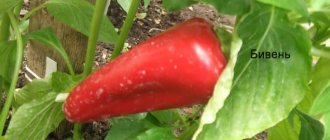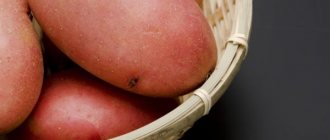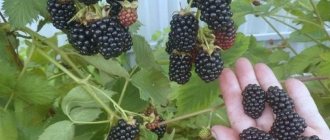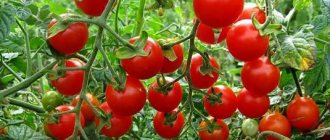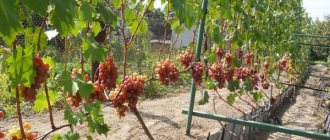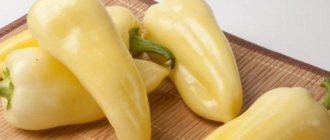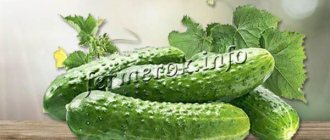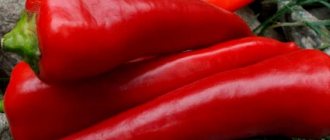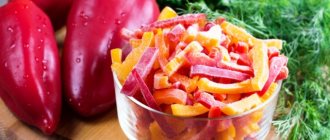Characteristics and description
Kakadu pepper bushes look like compact trees . They practically do not branch in the lower part, and reach a height of one and a half meters. The stems and trunk of peppers contain a large amount of hard fibers, which makes them durable. Therefore, the hybrid does not need a garter, despite the height and spreading nature of the plant.
Kakadu is a mid-season pepper ; 120-130 days pass from germination to fruiting. This hybrid can be used like any other sweet pepper. Fresh - for slicing and salads, eating stuffed. For the winter - for preparing preparations.
Attention ! Kakadu seeds cannot be collected for storage for next year, since this is a first generation hybrid (F1) and it is impossible to reproduce all its qualities.
Distinctive features
There are several main features due to which the Cockatoo hybrid can be distinguished from the rest:
- Tallness. The cockatoo reaches 100-120 cm in height. Some plants even grow up to 1.5 m.
- Appearance. Fruits of exotic shape and bright color look beautiful and impressive.
- Large fruit. The fruits of this pepper can reach a length of 30 cm and a weight of 500 g.
- Productivity. Up to 2.5-3 kg of peppers are collected from one Kakadu bush.
Pepper Kakadu f1: description and characteristics of the variety
Bell pepper Kakadu: photo of a sweet variety
Among vegetable crops grown by gardeners, sweet pepper occupies a leading position, being present in almost every plot. At the same time, many try to grow different varieties and hybrids of this vitamin-rich vegetable in order to choose the one they like best. And breeders only contribute to this desire, constantly surprising us with new and new achievements. These include bell pepper Kakadu f1.
Gardeners who have tried the Kakadu sweet pepper variety have been growing it for more than one season, noting that it fully complies with the declared characteristics in terms of high yield and rapid ripening of fruits.
Bell pepper Kakadu f1 is a hybrid variety. Fruiting begins 105-110 days after sowing the seeds, however, gardeners note cases of fruit appearing in a shorter time. The bush is erect, spreading, growing up to one and a half meters in height. Moreover, despite its impressive size, the plant does not need support or garter.
The fruits of red pepper Kakadu f1 are cylindrical in shape, tapering towards the bottom. The pepper got its name from its slight bend, which, according to breeders, resembles the beak of a cockatoo.
Fully ripened fruits have a bright red color, dense and juicy pulp, and a pleasant sweet taste. The size of the peppers is impressive. The weight of one bell pepper Kakadu f1, for example, can be up to half a kilogram, and the length is 20-30 cm. Up to 3 kg of sweet peppers are collected from one bush. By the way, for lovers of yellow sweet peppers there is also “Kakadu Yellow”.
Sweet Kakadu pepper is a heat-loving variety, so high yields can be expected in open ground only in the southern regions; in other regions, growing pepper, as well as other vegetable crops, is possible only in a greenhouse.
Preparation for cultivation
To begin with, the seed is placed in a bowl of salted water. High-quality seeds are heavy and will therefore sink to the bottom. The lightweight ones will remain on the surface - this is a defect, you should get rid of it.
Before sowing, the seeds are placed in a damp cloth and left in a warm room for a couple of days. The soil mixture should be loose and nutritious. You can buy special soil for growing peppers. If you take soil from the garden in the fall, it is important not to use it from the beds where nightshades grew.
Depending on the region, sowing takes place from late February to early April. To do this, the seeds are buried 1.5-2 cm with an interval of 5 cm between plants. Cover with film or glass and water every morning.
After the emergence of seedlings (7-10 days after sowing), the seedlings are moved to a bright place and, if necessary, additional artificial light is used.
Growing seedlings
After two true leaves appear, the plants are planted in different containers - peat pots or plastic cups. The third part of the spine is removed. This technique is called picking. For several days after this, the peppers must be protected from direct sunlight, then put them in a cool, bright place.
When sowing peppers directly into separate containers, they will not require picking. With normal seedling formation, fertilizing is not needed. If there are problems, then feed them with complex mineral fertilizers twice before planting in the ground.
The first time - after picking, the second - two weeks after the first feeding, when the third leaf is formed. Water in the morning as needed with settled water at room temperature.
Important! Before planting peppers in the ground, it is recommended to harden them. To do this, the seedlings are taken out onto the balcony or street, increasing the time the plants spend in the air every day.
Features of agricultural cultivation technology
Growing this hybrid in a greenhouse is not very difficult, but you will have to constantly monitor the development of the seedlings, as well as create the necessary conditions for them.
Seed preparation
To obtain high-quality seedlings, you should carefully select planting material and prepare the soil for planting. This issue needs to be addressed at the end of February. Kakadu pepper grains are delicate and sensitive, they quickly lose their germination capacity.
Algorithm for preparing seeds for planting:
- Careful selection of seed material. Inspect all the pepper grains and select the best ones. Next, prepare a saline solution (1 liter of water + 40 g of salt). Dip the grains into it and leave for about 10 minutes. Good seed remains at the bottom, while bad seed floats to the top. Remove the seeds, rinse under water and dry.
- Disinfection. Make a solution of water and a small proportion of potassium permanganate, and immerse the planting material in the solution for 15 minutes. Then rinse and dry.
- Enrichment with useful microelements. Carry out this activity 2 days before direct sowing in pots. Place the grains in a gauze bag and dip them in a special solution with microelements. Keep it in it for about a day, then remove it and dry it (no need to rinse).
- Germination. The method is very good, the grains begin to hatch after 24 hours. Place the seed material in gauze, wet it a little, and place it in a warm place. Plant grains only in moist soil.
By following simple steps, you will immediately receive material suitable for sowing.
Sowing seeds for seedlings
You can use peat tablets, or wooden boxes are also suitable. The soil for sowing seeds for seedlings should be as fertile and loose as possible. Sow the seeds at a depth of 15 mm, cover the containers with film or glass and place in a warm, windless place.
The key to high-quality seedlings is well-prepared seeds and correctly planted; after sowing the grains, keep an eye on them; the moment of seedling formation is especially important. At first, for about 2-3 days, keep the box near a heater or radiator, then move it to a window, closer to sunlight.
For plant growth, keep the temperature at +24...+26 degrees, at night lower it to +15...+17 degrees. Sprouts love light, so it is advisable to illuminate them with phytolamps. Daylight hours should not be shorter than 13 hours.
In the video below you can clearly see the method of planting the seeds of the Kakadu F1 sweet pepper:
Growing seedlings
Seedlings can be placed not only on the south side of the room, but also on the window sills of the eastern and western parts. Plants need to be watered as the soil substrate dries out; take only warm and settled water; cold water will kill them. Water either early in the morning or late in the evening.
Picking seedlings
If you planted the planting material in a large wooden box, then after the first 2 true leaves appear, the plants need to be pruned, that is, transplanted into separate containers.
Often, picking is carried out 2-3 weeks after the formation of the first shoots. Replant very carefully so that the root system of the pepper is not damaged, otherwise it will be almost impossible to restore the sprout.
At first, protect the seedlings from direct sunlight, then place them in a bright and cool place.
Feeding seedlings
Growing Kakadu seedlings requires fertilization. Feed for the first time when 2 leaves appear on the sprouts. Use urea, phosphate, potassium salt and water. Re-apply fertilizer 2 weeks after the first, use the same product.
2 days before transplanting the sprouts into a greenhouse or open soil, they must be hardened off. Take the seedlings out into the fresh air for a short time, just make sure that the temperature is not below +13 degrees Celsius.
Transplanting seedlings into open ground
The timing of transplanting seedlings depends on the growing region: in the south - at the end of May or early June, in the north - 14 days later. The area should be as illuminated as possible; if the soil in the garden is heavy or poor, then add compost to it (5 liters per 1.5 sq. m), also add wood ash (0.5 liters per 1 sq. m).
Dig up the soil and make beds in which you plant the sprouts in a checkerboard pattern. Leave the distance between seedlings in a row approximately 0.5 m, between rows - 1 m. Planting too densely leads to diseases and a small harvest.
Planting pepper
Peppers are planted in a permanent place when six or more true leaves appear. In the southern regions this is mid-May and later, in the middle zone - until the end of June, so that the threat of frost has passed.
Leave at least a meter between rows and 60 cm between plants. The most convenient planting pattern is in a checkerboard pattern. Plants are planted in cloudy weather. If this is not possible, then early in the morning or in the evening, when the sun is not yet so active.
Holes 10-12 cm deep should be generously shed with water before and after planting. Plants are mulched with straw, peat or humus.
If peppers are planted in a greenhouse, then do so 2 months after germination. By this time, the plants reach 30 cm in height and already have about 12 true leaves. The soil in the greenhouse should warm up to 15 degrees, that is, around May.
Further care
It is enough to water Kakadu peppers once a week before flowering, and twice when the fruits are forming. Watering is stopped 10 days before harvest. There are 3 liters of water per plant, after which loosening (to prevent crust formation) and mulching is carried out. In the greenhouse, watering is carried out every 2-3 days.
The first fertilizing is carried out a couple of weeks after transplanting the plants into open or greenhouse soil. To do this, mix bird droppings and water in a ratio of 1:15 or 1:20, or cow manure and water in a ratio of 1:10. Then leave in a warm place until fermentation ends and use 1 liter of fertilizer for each bush.
During the flowering period, spraying is carried out - 4 g of boric acid per 2 liters of water. After flowering, mineral fertilizer is applied under the peppers. To do this, mix 1 tsp. potassium sulfate and 2 tbsp. superphosphate and diluted in a bucket of water.
The last fertilizing is done when the fruits ripen. Take 2 tsp per bucket of water. potassium salt and superphosphate.
Important! All solutions are applied at the roots of plants in the morning or evening, when the sun is not active.
Caring for Kakadu Peppers
The productivity of a plant depends on the degree of care for it. Without proper care, pepper will not be able to surprise you with its unusually shaped fruits.
Watering and fertilizing
Fertilize peppers with complex and organic fertilizers. Apply the first fertilizer 2 weeks after planting the plant in open soil or a greenhouse. You can use urea, but droppings bring more reliable results; they are infused in a ratio of 1:15 with water. Water only the trunk circle of the hole with this mixture.
The second application of fertilizer is carried out during the flowering and ovary formation season. In addition to droppings, you can use mullein; it is mixed with water (1:10) and poured into grooves dug next to the plants.
Treating the leaves and buds of pepper with an infusion of ash - 400 ml per 1 bucket - is beneficial. The third application of fertilizer is carried out with liquid chicken droppings during the beginning of fruiting of the Kakadu hybrid.
Water the seedlings at least once a week, in a greenhouse - every other day. Use only warm and settled water, otherwise the plants will get sick and die. After watering, loosen the soil and the water will become more breathable and moisture permeable.
Mulch plays an important role; use turf soil or humus as the material.
Pruning shoots
Without high-quality formation of bushes, you cannot get a good harvest. Carry out the first pruning at the seedling germination stage. After the formation of the first 5-6 leaves, pinch the upper growing point, thanks to which the plant begins to grow lateral shoots, on which the fruits will form. After transplanting into open soil, cut off the stepsons formed in the internode, leaving a stump of 20 mm in size intact.
Harvest and storage
Plant yields will be higher if the fruits are cut during technical rather than biological ripeness. This advice especially applies to the first fruits; you should not let them turn red on the bushes, otherwise they will begin to inhibit the development of new ovaries.
Pods collected at the technical maturity stage are stored longer. They taste the same as the red pods, but they have more benefits. The Kakadu pepper variety has a unique purpose. The fruits are juicy and tasty, intended for preparing various dishes and preserves.
Stuffing them is not particularly convenient due to their curved appearance and too large size. They are best used for salads and snacks. The best option for storing fruits is freezing.
Features of growing peppers and possible difficulties
Kakadu is a tall pepper, which needs to be taken into account when caring for it. To prevent the plant from growing and directing all its forces to the formation of fruits and not stems, it must be formed correctly. To do this, remove all side shoots up to the first fork, as well as all branches below the ovaries.
You should choose a place to plant a Cockatoo carefully. If it is open ground, then you need to find an area protected from possible gusts of wind. If pepper is grown in a greenhouse, then it is planted so that tall plants do not block the light of other greenhouse crops.
Attention! If it is above +30°C in the greenhouse, pollination will not occur and the flowers will fall off. Therefore, it is important to take care of ventilation. In hot weather, simply opening the windows is not enough - you also need to raise the film sides.
To prevent the lower fruits of the pepper from touching the ground, be sure to mulch with clean material. It will also retain moisture in the soil longer and prevent weeds from germinating.
Typical diseases and pests
Kakadu pepper is rarely affected by diseases and pests, but every gardener needs to know about them.
- Fungal diseases (late blight). Prevention - 10-15 days after planting in the ground, spray with a solution of Bordeaux mixture. In case of defeat - “Oxychom” and “Phytodoctor”. In case of severe defeat - “Ridomil Gold”, “Barrier”, “Barrier”.
- Aphids, spider mites, gall midges, wireworms, mole crickets. Insecticides - “Fufanon”, “Karbofos”, “Aktellik”, “Fosbetsid”. Folk remedies - tobacco dust, infusion of garlic or onion peelings, water infusion of ash or tobacco. Quickly decomposing insecticides - "Keltan" and "Karbofos".
- Apical rot of the fruit. Prevention - treating seeds with a solution of copper sulfate or potassium permanganate. Not only the plants themselves are treated, but also the soil underneath them, as well as the internal surfaces of the greenhouse. If affected, spray with calcium nitrate.
Reference. Treatment with insecticides is carried out in the morning, before flowering, but not during the fruiting period of pepper.
Care
For optimal growth and development of peppers in a greenhouse, the following should be carried out in a timely manner:
- mulching;
- ventilation;
- watering;
- formation;
- feeding;
- garters to supports;
- inspections to identify pests and pathogens.
When reading the description of the Kakadu pepper variety, you need to understand that if the length of the pepper fruit is 20-25 cm, then the lower fruits can touch the ground. This is often what happens. To prevent this from happening, it is necessary to mulch.
It is necessary to mulch the soil near the trunk and around the circumference with artificial or natural material, but certainly clean, not contaminated with pathogenic microflora. If this material has been used for nightshade mulch before, it is treated by spraying with a solution of copper sulfate.
When growing peppers in a greenhouse, you should constantly monitor temperature indicators. As soon as the thermometer reaches 29 ᵒC, thorough ventilation should be carried out. Sometimes, when it is very hot, it is not enough to open the windows, so experienced vegetable growers raise the film sides.
Kakadu peppers require careful shaping and tying. When the central shoot rises to 30 cm, it needs to be pinned down. It is this height that will allow the first fruits not to lie on the ground.
Being a fairly wide-set bush, it is necessary to constantly lighten its middle from shoots. To do this, it is enough to pinch each shoot that still wants to grow towards the center of the bush.
Feeding
“Kakadu” produces a lot of fruits, but in order for them to ripen and increase their marketable weight to 200 g, timely feeding is necessary.
The first should be made of nitrogen and carried out 2-3 weeks after planting in the greenhouse. To prepare a nutrient solution, dissolve 2 tbsp in a bucket of water. spoons of ammonium nitrate or urea in a bucket of water and pour half a liter jar under the bush.
Advantages and disadvantages
Before purchasing Kakadu pepper seeds, you should familiarize yourself with its pros and cons.
Advantages:
- unusual appearance;
- pleasant sweet taste;
- high productivity;
- large fruit;
- resistance to diseases and temperature changes;
- Harvesting continues until late autumn (September-October).
Flaws:
- takes up a lot of space;
- tall, so it can reduce yields if it is crowded;
- in open ground, the wind can break off shoots;
- the lower fruits may rest against the ground.
Reviews
Reviews about Kakadu pepper are very contradictory. Some gardeners are dissatisfied with the low yield and weight of the fruit, while others call the variety one of the most beautiful and productive of all that they have grown.
Larisa, Tula: “This year I started growing peppers for the first time. The Kakadu bell pepper was recommended to me by a salesperson at a local store for summer residents. The pepper has a funny tip, reminiscent of the beak of the parrot of the same name. The fruits are juicy and tasty. True, the walls are not particularly thick.”
Diana, Serov: “I have been sowing Kakadu pepper for several years now and am pleased with the result. The fruits are large, shiny, juicy and aromatic. They have thick walls and store well. Peppers begin to bear fruit within 2-3 weeks after planting in the ground! In a greenhouse or greenhouse, I collect fruits until October, and they weigh up to 600 grams! I use kakadu both for soups and salads, and for preparations for future use. Out of 10 seeds, it’s rare to find 1-2 that don’t germinate. I’m very pleased with the results!”
Camellia, Volgograd: “ I bought Kakadu pepper seeds for 45 rubles. The pack says 0.2 g, it came out to 39 pieces, 28 of them sprouted, but not a single one died. I read on the Internet that the germination rate is 94%, but I got 72%. The height indicated is 1.5 m, I didn’t go higher than a meter. The weight on the pack is 500 g, my largest was 380 g. The fruits are long, so the lower ones rest on the ground. But the pepper is still large and tasty, I plant it every year and recommend it to everyone. Of the minuses, I would like to note the price. Also, Kakadu peppers are not suitable for stuffing due to their size and for collecting seeds. Pros: sweet and large, thick walls. I wish everyone a successful harvest!”
Reviews of Kakadu pepper
Many gardeners note very important features characteristic of Kakadu pepper:
- this culture is suitable for use in many types of cooking; the range of its use for food purposes is almost unlimited;
- When growing peppers, pinching is necessary;
- Kakadu pepper seeds sprout very quickly;
- pepper quickly adapts to climatic conditions and gets used to the soil;
- the plant ripens quickly and quickly bears fruit.
For this reason, most gardeners often tend to grow the Kakadu variety rather than other varieties of pepper crops.
